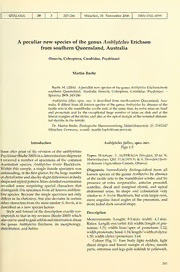
A peculiar new species of the genus Amblytelus Erichson (Insecta, Coleoptera, Carabidae, Psydrinae) from southern Queensland, Australia PDF
Preview A peculiar new species of the genus Amblytelus Erichson (Insecta, Coleoptera, Carabidae, Psydrinae) from southern Queensland, Australia
SPIXIANA Fig.1. Aiublytcliisfallax,spec. nov.,holotype.Habi- Fig. 2. Amblytehisfallax, spec. nov.Arrangenientof tusand colour pattern. Length: 9.5mm. chetotaxy. Length: 9.5mm. darklateralstripesofelytrapiceoustoalmostblack, and2; anterior supraorbital (either side): 1; poste- thesuturalstripereddish.Sutureofelytraincluding riorsupraorbital (eitherside): 2. 2"^^ intervaldark,darklateralstripesoccupyingthe Pronotum (either side): anterior pronotal: 3; lateral two thirds of 6"' interval and the whole 7"' posteriorpronotal: 1. interval, margin light from 8"' interval onwards. Elytra: scutellar(eitherside): 2; 1"interval: 5-8; Sutural stripe not reaching base, gradually fading 3'^^^ interval: 18-19; 5"^ interval: 22-23; 7"' interval: towards base. The light discal stripes ending at a 23-25; marginal: 19-21;apical: 4-5. Shortdistancefromapex,apexofelytracompletely Abdomen (either side): female terminal: 4-5; reddish, because the black lateral stripes are also male terminal: unknown. abbreviated nearapexand arefading intoreddish. Head. Ratherwide,depressed,aboutonefourth Chetotaxy (Fig.2; different from the revision, narrowerthanpronotum. Eyesverylarge,laterally chetotaxyisnotabbreviatedduetothemanydiffer- markedlyprotruded,orbitsshort,veryoblique,very ences from allotherspecies). slightly convex, evenly merging into curvature of Head: labial: 6; clypeal (either side): 1; man- eye. Labrumanteriorlyslightlyconcave.Manciibles dibular: 0; mental: 2; submental (either side): 1 moderatelyelongate,differenttoallotherspeciesof 244 Amblyteliniscrobewithoutanytraceofmandibular pore and seta. Tooth of mentum large, wide, api- cally convex. Glossa transverse at apex, bisetose, paraglossae hyaline, barely surpassing glossa. La- cinia with few very strong spines. Both palpi ob- liquelycutatapex, sparselyand very finelypilose. Antennaelongate, surpassingbaseofpronotumby c. 3 antennomeres. Median antennomeres c. 3x as long as wide. Posterior supraorbital setae slightly removed from eye, situated at posterior margin of eye.Frontalfurrowsshallow,aboutcircular.Surface absolutely smooth, without any punctuation and microreticulation, veryglossy. Pronotum. Wide, somewhat cordiform, dor- sallyratherconvex.Apexmoderatelyconcave,api- calanglesverywidelyrounded,slightlyprotruded. Lateral margin convex throughout, basal angles distinct though obtuse, forming an angle of about 110°. Base slightly convex, but laterally barely ex- cised. Apex in middle not margined, base finely margined. Marginal Channel moderately deep, lat- eral margins wide, widened towardsbase, slightly rexepalcahniantgeaapnedxunpotrurmnaerdg.inM,edbioathnlainnteerdiisotrinacnt,dnpeoistthee-r Friegs.13.anAdmb2l.ytSecallues:fa0l.l2axm,ms.pec.nov.Femalestylome- rior transversal sulci very shallow. Basal grooves aboutcircular,barelyseparatedfrommarginalChan- S genitalia. Unknown. nel. The three anteriorlateral seta inserted in ante- 9 genitalia (Fig.3). Female stylomere 2 fairly riorhalf, situated inmarginal Channel farremoved elongate,regularlycurved,with2largelatero-ven- from margin. The posterior lateral seta arising at tral ensiform setae, a large medio-dorsal ensiform lateral margin very slightly in front ofbasal angle. setasituatedatapicalthird,andtwoshort,attached Surfaceabsolutelysmooth,withoutpunctuationand nematiforni setae originating from a groove near microreticulation, very glossy. apex.Stylomere1ratherelongate,longerthanwide, Elytra. Moderatelyelongate,moderatelyconvex, with 3 Short ensiform setae of slightly decreasing distinctlywidenedposteriorly,widestatapicalthird. size situated on latero-ventral rim. Lateral plate Humeri widely rounded, lateral margin gently ventro-mediallywithafieldofdenselypacked,very convex, in middle almost straight, at apex convex short, knob-shaped ensiform setae. though with slight excision where the apical epip- Variation. Unknown. leuralfoldmeetsthemargin.Apexofeitherelytron gently angulate, hence elytra slightly dehiscent at Distribution. South-easternQueensland,Australia. suture. Lateral apical fold very strong. All Striae Known onlyfrom type locality. complete, rather deep, at bottom finely crenulate, intervalsdepressed.Scutellarporeandsetadoubled, CoUecting circumstances. CoUected on "Banksia alloddintervals,includingthefirst,withremarkably flowers". numerous setiferouspunctures (s. chetotaxy), mar- Etymology. Latin "fallax" means "fraudulent" and re- ginalChannelalsounusuallymultisetose,seriesvery fersto themockingnumberofsetaeonalmostallbody slightlyinterruptedbehindmiddle. Intervalsfinely parts thatusuallybeartactilesetae. and rather sparsely punctulate, distinctly though veryfinelyandrathersuperficiallymicroreticulate, meshes about isodiametric to slightly transverse. Remarks Surfaceratherglossy. Posteriorwings. Fullydeveloped. It is surprising why this peculiar species has been Lowersurface. Metepisternumveryelongate,c. so far collected in a Single specimen only and was 3X as longaswide at apex. Abdominal sterna uni- not represented in the thousands of specimens of setose on either side, terminal sternum s. cheto- bilineate Amblytelus from south-eastern Australia taxy. thatIhaveexaminedinthecourseoftherevisionof Legs. Ofaveragesize. this genus. The exceptional chetotaxy ofthe Single 245 availablespecimen ofthenewspecies, incombina- Evenwhenthenewspecieslacksthemandibu- tion with the likewise unusual collecting circum- larsetawhichabsenceisuniquewithinAniblytelini stances renders this a quite enigmatic species, and in general, I guess thatitmaybeyetratherclosely thus itmaybeallowed to speculate aboutpresum- related to the c;/;'fus-fcrei7fs-sznMflh(s-assemblage of ably aberrant habits. Normally, in south-eastern rather large, quite similarly shaped and patterned Australia, species ofthegenusAmbh/teliis, butalso species that bear bilineate elytra with multisetose amblyteUnesingeneral,arefoundeitherunderbark oddintervals,andwhicharecommoninopenforests ofbark-sheddingeucalyptsinopensclerophyllfor- of south-eastern and south-western Australia (for estorwoodland,oronmossyfreetrunksintemper- more Information see Baehr 2005). Unfortunately, ateandsubtropicalrainforest. Reportsofamblyte- the male genitalia of A.fallax which could either hnespecimenscoUectedonfloweringplants areso corroborate or refuse this assumption are still un- farunknown to me. However, atpresent and with known. a Single specimen only, it seems superfluous to speculatewhetherthismaybetheregulärhabitsof thisspecies. Buttheremarkablymultipliednumber Acknowledgements oftactilesetaeonthewholebodyand,ontheother hand,thelossofthemandibularsetathatispresent IamindebtedtoP. Bouchard,Ottawa,forthekindloan in all other amblyteline species, must be of some of this and a great number of other Australian speci- ecologicalsignificance.Futurecollectorsofamblyte- mens. Unesthusareadvisedtopayspecialattentiontothis habitat. References Baehr, M. 2005. TheAmblyteUni. A tribe ofcorticolous ground beetles from Australia. Taxonomy, phylo- geny, biogeography (Insecta, Coleoptera, Carab- idae, Psydrinae). -Coleoptera 8: 1-286 (2004) 246
